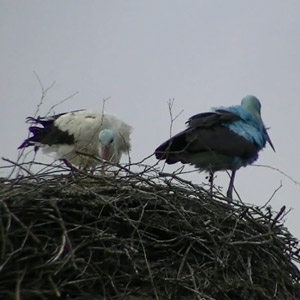Magazine | Analyses
Cigognes bleues allemandes : une couleur improbable naturellement

Cigogne blanche (Ciconia ciconia) teintée de bleu à Biegen (Allemagne) le 14 avril 2010. Notez que l’oiseau de gauche a des traces de bleu sur la tête, suite probablement à un contact avec son partenaire coloré.
Source : La chaîne de Mr Pendecho sur Youtube
Introduction
Le 5 avril 2010, les habitants du village de Biegen, en Allemagne, ont eu une drôle de surprise : une Cigogne blanche (Ciconia ciconia) bleue a installé son nid sur un bâtiment horticole, attirant de nombreux visiteurs. Le 14 avril, c’est à Avendorf, dans le Nord du pays, qu’un oiseau similaire est apparu.
Ces curieux oiseaux attirent des experts du monde entier qui s’interrogent sur l’origine de sa couleur, qui ne semble pas naturelle. Les a-t-on peintes, ont-elles été les cibles de joueurs de paintball ? Ont-elles été en contact avec des produits chimiques lors de leur trajet de migration ? Jusqu’à présent, aucune analyse de plume n’a été réalisée, mais le bleu n’est pas naturellement d’origine pigmentaire chez les oiseaux.
Alberto Masi a profité de cette actualité insolite pour nous expliquer comment le plumage de certains oiseaux nous apparaît bleu et s’il serait possible d’expliquer la teinte de ces cigognes par une mutation particulière.
Abstract
The 5th of April 2010, a mysterious Blue Stork appeared in Biegen, a small village of Brandenburg (Germany). The 14th of April, a second bird was discovered in Avendorf, in the north of the country. Experts are trying to understand the origin of this color, which doesn’t seem to be natural: Stained in a landfill? Victims of a paintball gamer? So far, no feather has been analyzed.
Alberto Masi, creator of the software Neornithes, explains us why some birds are blue. This colour is a structural color, or schemochrome, and results from small changes in feather structure that alters their light reflective properties. Because blue light has a very short wavelength, it is selectively reflected more easily than other colors of light with longer wavelengths, thanks to the « Tyndall scattering » effect. Some authors think that structural colours of avian feather barbs are produced by constructive interference instead of Tyndall effect.
Alberto also wonders if some mutations could explain the strange blue of these storks.
Poursuivez la lecture de cet article, en vous abonnant dès maintenant !
Découvrez les Archives d’Ornithomedia.com
Pour seulement 10,00 €TTC/an (ou 6,00 € les 6 mois)
Profitez de plusieurs centaines d’articles en accès illimité et sans aucun engagement.
Compléments
Ouvrage recommandé
Reconnaître facilement les plumes : Collecter, Identifier, Interpréter, Conserver de Cloé Fraigneau
Sources
- Devorah A. N. Bennu (2000). The Physics of Structural Colors in Bird Feathers [Schemochromes]. www.turacos.org/feathers.htm
- Thirdeyehealth.com. Blue Eye The Melanin Scarcity. www.thirdeyehealth.com/blue-eye.html
- Rüdiger Finke (2010). Blauer Storch landet in der Elbmarsch. Date de mise à jour: 14/04. www.welt.de/diewelt/vermischtes/hamburg/article7173110/Blauer-Storch-landet-in-der-Elbmarsch.html
- Welt Online (2010). Kneipe und Karten: Storch füllt Biegens Kasse. Date de mise à jour: 23/04. http://newsticker.welt.de/?module=dpa&id=24607356
- Wikipedia (2010). Iridescence. http://fr.wikipedia.org/wiki/Iridescence
- Bernard Valeur. Les couleurs des animaux. www.cnrs.fr
- Maurice POMAREDE (2003). La couleur des oiseaux et ses mystères. Le Monde des Oiseaux. www.webzinemaker.com
- University of Bristol. Melanosomes from other deposits. Palaeobiology and Biodiversity Research Group. http://palaeo.gly.bris.ac.uk/melanosomes/Messel.html
- Canarich. Les différentes opales. http://canarich.skyrock.com/2.html
- Inte Onsman. The Myth of the Tyndall Effect in Blue Bird Feathers. MUTAVI Research & Advice Group. http://www.euronet.nl/users/hnl/tyndall.htm
- R. O. Prum, R. Torres, S. Williamson, and J. Dyck (1999). Two-dimensional Fourier analysis of the spongy medullary keratin of structurally coloured feather barbs. Proceedings of the Royal Society B: Biological Sciences. Volume 266. www.ncbi.nlm.nih.gov/pmc/articles/PMC1689643/




Aucun commentaire sur ce sujet
Participer à la discussion !